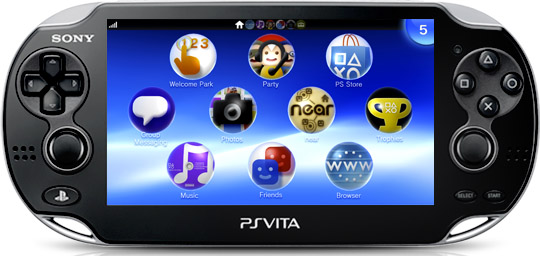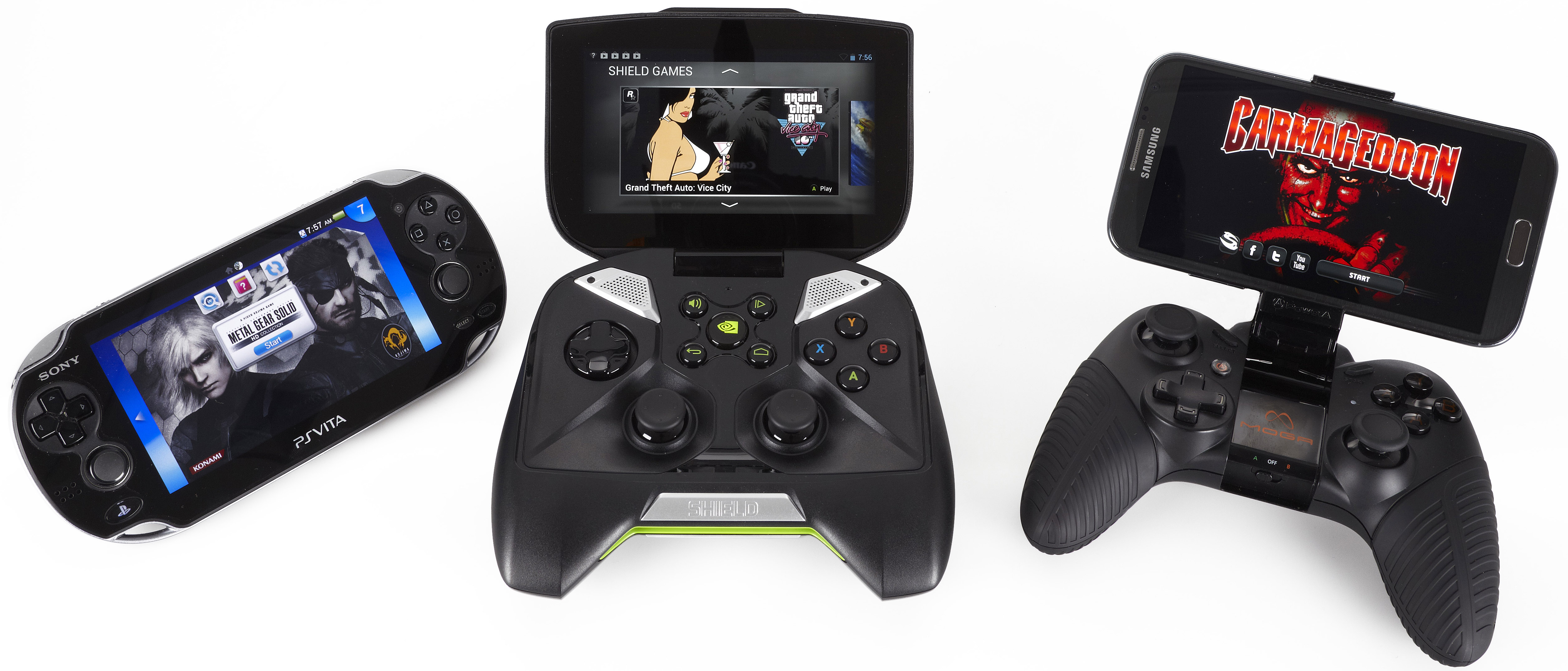Nvidia Shield Review: Tegra 4-Powered Handheld Gaming
We've been playing with Nvidia's Shield handheld for more than a month, but only recently got access to its killer feature: streaming PC game content. Does Nvidia's foray into the hardware world deserve your $300, or is this expensive toy impractical?
Shield Vs. PlayStation Vita Vs. 3DS
Nvidia Shield vs. PlayStation Vita
Comparing Nvidia’s Shield to Sony’s PlayStation Vita gets even more subjective. Both are positioned as dedicated gaming machines, but they employ completely different platforms. Still, it's worth looking at them together, particularly if you don’t already own an Android-based smartphone, or if you’re looking for a dedicated portable gaming device.
When it comes to hardware, the Shield wins. Nvidia's machine has a faster SoC, more memory, and a bigger battery. Both devices sport five-inch screens. But the Shield sports a 1280x720 LCD, whereas the Vita’s native resolution is 960x544. Both come equipped with touchscreens, though the PS Vita adds a track pad on the back. The Shield also includes analog triggers and clickable analog sticks.
Of course, as a gamer, tech specs are fun, but it all comes down to the content, really. In that face-off, the Vita and Shield trade blows. The PS Vita comes from a hardcore gaming background, so you’re going to find specific titles that simply aren’t available through Google Play. File Uncharted, Persona 4, and Little Big Planet in that category. If you’re more into casual titles, you’ll find plenty in Google’s store, and at much lower prices. PS Vita games cost upwards of $40 each, and even the same game on both platforms usually costs more for the Sony machine. As an example, Plants vs. Zombies sells for $14.99 on the PlayStation Store and just $0.99 on Google Play. That's just crazy.
Enthusiasts looking for a more serious experience are going to find it on the PS Vita. Need for Speed: Most Wanted is available for Android and the PS Vita, but the latter approximates the version we love on PC and consoles. There’s still a big price disparity (you pay around $25 from Amazon for PS Vita and $6 on Google Play) But if the Shield can give us an optimized PC streaming experience, the story changes substantially…
On the topic of streaming, both devices have their own proprietary technologies. The PS Vita offers a feature called Remote Play, analogous to what the Shield can do when it’s paired to a GeForce GTX 650 or higher. Remote Play tasks a PS3 with rendering a game, while the PS Vita displays a video output stream and sends controller input. This feature is used infrequently today, but Sony is making it mandatory for developers making games for the PS4. If you’re planning on buying a PS4, then your PS Vita could get even more useful. On the other hand, Shield can do this for a number of PC games today.
As far as media streaming goes, both platforms support Netflix. The PS Vita still doesn’t have a Hulu Plus app, though (despite its promise more than a year ago). A higher-resolution screen and better speakers make the Shield a better device for content consumption, we think. Conversely, you can get a PS Vita with 3G connectivity for $300.
Get Tom's Hardware's best news and in-depth reviews, straight to your inbox.
Deciding between the two platforms is really a matter of taste. The PS Vita retails for $250, a full $50 less than Shield. Nvidia’s solution is much beefier, and includes Android, making it much more flexible than the PS Vita. But portable gaming on Shield is a bit more mainstream compared to Sony’s platform.
Nvidia Shield vs. Nintendo 3DS
It’s even harder to compare Shield and Nintendo’s 3DS. For one, the technical differences get even more obscure. The 3DS has two screens, the top one delivering a glasses-free stereo picture at 800×240 (that’s 400×240 per eye), while the bottom offers a resistive touchscreen at 320x240. Combing 3D and a stylus-based touch experience, gaming on the 3DS is unlike any other platform.
Nintendo's first-party games are also unique in that they’re the only places you’ll find the Mario, Zelda, and Animal Crossing franchises.
The pricing difference are also significant enough that both handhelds appeal to separate markets. Nintendo’s 3DS retails for $170, while the 3DS XL (armed with larger screens, but no additional resolution) sells at $200.
You’ll find a Netflix app for the 3DS, though its Hulu Plus implementation still isn’t available, similar to Sony’s PlayStation Vita. Based on resolution alone, though, Nvidia’s Shield gets the nod for streaming video content. Unfortunately, the 3D content available on Netflix doesn’t play back in stereo on the 3DS, which would have been a big advantage favoring the Nintendo handheld. Unlike the Shield and PS Vita, the 3DS doesn’t offer any functionality to stream game content from a PC or console.
As with our comparison between the Shield and PS Vita, pitting Nintendo’s against Nvidia’s effort comes down to taste. It's just that the 3DS is furthest from Shield on the spectrum in pricing, hardware, and software.
Current page: Shield Vs. PlayStation Vita Vs. 3DS
Prev Page Shield Vs. Galaxy Note II And Moga Pro Next Page Streaming PC Games To Shield-
Hazle impressive, especially PC streaming. but for $300, i'd rather pause the game to take a bathroom break. it's gonna take me a library of good android exclusives for me spend that amount of money, and PvsZ or Angry birds don't cut it.Reply -
beta212 Meh, with the PS4/xbox coming out , and tons of more convenient phones I don't see a market for a tegra4 shield, personally I'm saving my money for a console. The tegra is also too expensive and gimmicky to boot.Reply -
dragonsqrrl When you look purely at the performance and specs $300 unsubsidized isn't all that bad considering the hardware you're getting for the price. The problem to me isn't so much price but the target market. How many people are willing to spend that much on a second or potentially third mobile device meant specifically for gaming and entertainment?Reply -
bryonhowley Looks nice but I can find things better to spend $300 on. In truth I can't see ever streaming my PC games to a 5" screen when I use 3 Asus 27" monitors on my desktop PC. Going from 5760x1080 to 720p does not sound like something I am ready to do. And if I want to game from my recliner I just use my Xbox 360 wireless controller and play the game on my Panasonic 50" 3D Plasma.Reply -
vaughn2k for U$180, I can get a nice Lenovo Phone. For U$ 500, a good Xbox.. not sure if I need a Shield where I could play anywhere..Reply -
slomo4sho Not sure why most of your benchmarks were just between the shield and the Nexus 7. I understand that the Nexus 7 utilizes Tegra 3 but the iPhone 5, Note 2, or some other tertiary figues should have been included to provide a better comparison between this device and other current generation products.Reply
This device feels like a universal Wii U game pad and there is almost zero reason to own one. -
cats_Paw Considering that Oculus rift will cost somewhere around 300 dollars as well, id rather wait for that to spend my cash.Reply
Streaming is nice but if you are close toy our pc why not use the PC itself?
-
shikamaru31789 I'm just not seeing much reason to get one right now, not when I'm saving for the Xbox One and PS4. If it was at a lower price and if it supported AMD GPU's for PC streaming, I might get one. But they also need to get some developers to make some good Android exclusives, not just your typical mobile time wasters and ports of older console/PC titles, but some actuallAAA exclusives that are optimized for Tegra 4.Reply



